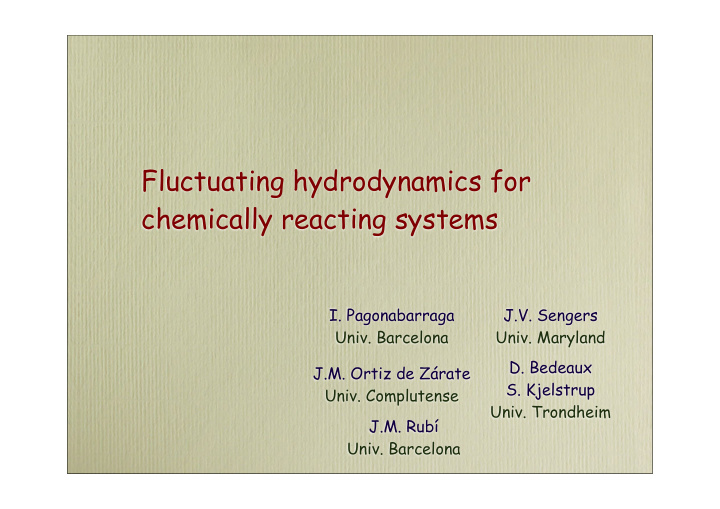



Fluctuating hydrodynamics for chemically reacting systems I. Pagonabarraga J.V. Sengers Univ. Barcelona Univ. Maryland D. Bedeaux J.M. Ortiz de Zárate S. Kjelstrup Univ. Complutense Univ. Trondheim J.M. Rubí Univ. Barcelona
1. Introduction 2. Mesoscopic Non-Equilibrium Thermodynamics (MNET) 3. Fluctuating MNET 4. Reacting mixtures under temperature gradients 5. Conclusions
1. Introduction Nonequilibrium thermodynamics linear relation between reaction flux and chemical potential differences Correct for small departures from equilibrium In general, reactions evolve according to law of mass action Is it possible to derive consistently from non-equilibrium thermodynamics formalism? Consistent coupling to other transport processes Include thermal fluctuations
2. Mesoscopic Non-Equilibrium Thermodynamics Need to expand the parameter space and account for the detail of the reaction process Reaction complex as an multicomponent mixture: Compact variable: natural coupling to spatially dependent variables Natural connection to Eyring/Kramers picture of a chemical reaction from thermodynamic perspective Generalized to other kinetic models assume separation of time scales (can be relaxed?)
2. Mesoscopic Non-Equilibrium Thermodynamics Density along internal coordinate as a probability connection to kinetic description: Kramers’ Apply non-equilibrium thermodynamic formalism from Gibbs entropy Chemical potential of a mixture Effective potential: reaction complex Extreme values: connection to chemical species
2. Mesoscopic Non-Equilibrium Thermodynamics Obtain balance equations: Derive flux/force relations from entropy production in extended space chemical viscosity neglected Active process at an interface: additional flux/force couplings
2. Mesoscopic Non-Equilibrium Thermodynamics Reaction along internal coordinate transformation reactants -> products Diffusion in terms of Onsager coefficient Quasi steady state assumption high energy barrier reaction complex Identify reactants and products in two basins
2. Mesoscopic Non-Equilibrium Thermodynamics Identify local reaction flux Compatible with law of mass action Gulberg-Waage Thermodynamic expressions for reaction constants
2. Mesoscopic Non-Equilibrium Thermodynamics Connection kinetic/NET expressions/concepts Connection kinetic/NET expressions/concepts Identifies fugacities as relevant quantities in law of mass action
2. Mesoscopic Non-Equilibrium Thermodynamics Transport coefficients in the presence of a chemical reactions: integrating over internal variable Effective kinetic coefficients in terms of average over internal coordinates Effect of chemical reactions on transport coefficients Nonlinear effects of reaction may lead to relevant couplings
3. Fluctuating MNET Generalize the formalism to account for hydrodynamic fluctuations Express including variations along internal coordinate Exploit the standard formalism from NET Gaussian fluctuating fluxes that satisfy detailed balance in extended space
3. Fluctuating MNET How do we derive the properties of the random fluxes in real space? Need to integrate over internal coordinate In quasisteady regime: total fluctuating reaction flux uniform
3. Fluctuating MNET Integrated fluctuating fluxes retain its Gaussian character If reaction controlled by the reaction complex = Consistent with law of mass action Second moment has a clear thermodynamic interpretation
3. Fluctuating MNET The same procedure can be applied to all fluctuating fluxes to derive the corresponding second moments in real space
4. Reacting mixture under a thermal gradient Effect of non-linear kinetics in correlation outside equilibrium? Consider a fluid mixture reacting under a thermally imposed gradient What is the reference steady state? Assume a conducting configuration reaction penetration depth
4. Reacting mixture under a thermal gradient Linearize around maximum flux neglect details of boundary conditions neglect dependence transport coefficients on temperature gravity longest length scale assume large Lewis number Analyze correlations of concentration fluctuations
4. Reacting mixture under a thermal gradient Mode-coupling Non-linear concentration profile
4. Reacting mixture under a thermal gradient Main contribution
4. Reacting mixture under a thermal gradient Correlations in static correlation Amplitude quadratic in gradients Crossover at penetration length
5. Conclusions MNET consistent framework to account for kinetic processes in a thermodynamic description Law of mass action comes out naturally Connection with thermodynamic quantities Internal variables Identify fluctuating fluxes generalized to coupled reactions Fluctuating MNET Effect of law of mass action on non-equilibrium correlations Enhancement of correlations dependence on penetration depth
Recommend
More recommend